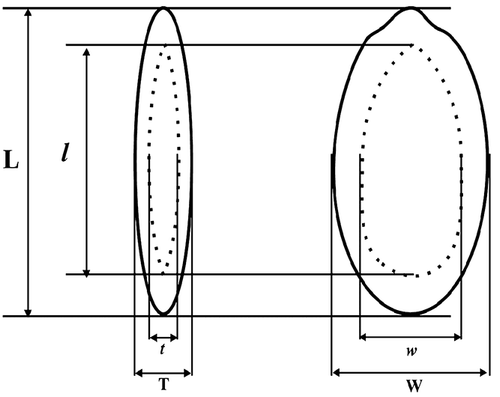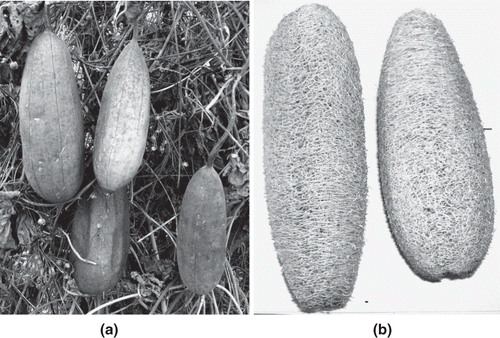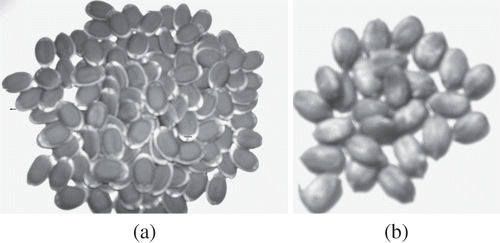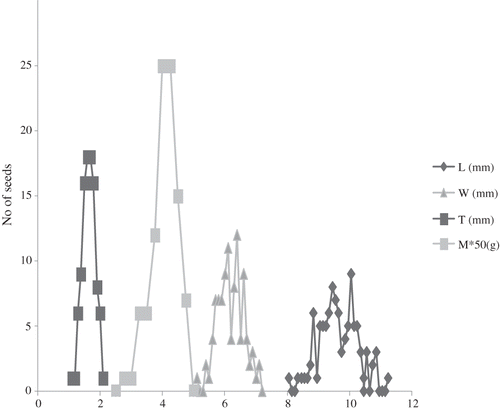Abstract
Some physical, mechanical and compositional properties of sponge gourd seeds were determined according to standard methods. The length, width, thickness and equivalent diameter were 9.6, 6.17, 1.59 and 4.53 mm for whole seeds and 6.99, 4.31, 0.79 and 2.84 mm for the dehulled seeds respectively. Sphericity, surface area, seed mass, bulk density, apparent density and porosity were 0.47, 0.57 cm2, 0.079 g, 0.43, 0.50 g/cm3 and 0.14 for whole seeds and 0.41, 0.33 cm2, 0.044 g, 0.57, 0.93 g/cm3 and 0.39 for dehulled seeds, respectively. Coefficient of friction against wood, aluminum, galvanized steel and mild steel surfaces were 0.50, 0.59, 0.64 and 0.70 for the whole seeds and 0.55, 0.66, 0.67, and 0.76 for the dehulled seeds, respectively. Sponge gourd seeds contain 33.38 and 39.11 g of protein and fat per 100 g of sample, respectively, the fat being largely made up of 50.1% linoleic and 31.03 % stearic acids.
INTRODUCTION
Sponge gourd (Luffa aegyptiaca) is of the cucurbitaceae family of plants, which are generally found in the warmer regions of the world.[Citation1] Immature cucurbitaceae fruits such as pumpkin, cucumber and some gourd plants are generally eaten as fresh fruits or cooked vegetables in different parts of Africa and Asia.[Citation2] In Nigeria, cucurbitaceae seeds are generally known as egusi based to their broadly similar physical characteristics and common use of some members of the family in native food preparations. The seeds are roasted and eaten as a food snack or powdered and prepared as curries, but the use of sponge gourd seeds for such food applications have not being reported.[Citation3,Citation1] Egusi is powdered and cooked with leafy vegetables, fish, meat and seasoning into a popular soup otherwise called obe osiki among the Yorubas. obe osiki is widely eaten with yam or cassava based staples like pounded yam (iyan), amala, foofo or eba as choice delicacies. In Nigeria, no part of sponge gourd plant is eaten and it is not cultivated, but it grows richly in the wild in its season. At maturity, the fruit dries up, turns brown and afterward, breaks at the tip creating an aperture thorough which the loose seeds get discharged (). The name, sponge gourd, originated from the spongy and fibrous nature of its seed-bearing vascular bundles which is useful as a biodegradable domestic sponge in the rural areas of Africa and Asia ().[Citation4] Usually, the seeds get wasted everywhere,[Citation2,Citation4] but the sponge is used industrially as a material for packing mattresses and upholstery; thermal insulator for containers; raw material for water and oil filters and as sound deadener for acoustic materials.[Citation5,Citation6] The whole seeds are usually black, structurally similar to watermelon (Citrullus lanatus) seeds but have flanges along the edge (). The dehulled seeds have a very thin, green outer seed coat speckled with dark grey colour.
The properties and composition of cucurbitaceae seeds such as: egusi ibara (Citrullus colocynthis), egusi itooro (Cucumeropsis mannii), egusi elegede (Cucurbita pepo), egusi igba (Lagenaria siceraria), watermelon (Citrullus lanatus), snake gourd (Trichosanthes cucumerina), bitter gourd (Momordica charantia), and so on, have been widely studied.[Citation7–20] They contain about 50 and 35% of crude fat and protein respectively[Citation2] and the presence of significant amount of minerals and vitamins, which are vital in human, and livestock nutrition have been reported. They are rich sources of essential amino acids such as arginine, tryptophan, and methionine. Their oil is largely made up of unsaturated fatty acids, thus of high nutritional value. Their fatty acid profile generally show a high concentration (60–70%) of linoleic acid and the presence of oleic, stearic and palmitic acids.[Citation3] The presence of conjugated fatty acids among some cucurbit oils make them highly suitable for frying.[Citation2] Borne out of the need to harness the nutrient potentials of some of the lesser-known oilseeds, their use as sources of vegetable oil and protein has been reviewed.[Citation4,Citation8,Citation9,Citation20] Some of these seeds are relatively rich in protein and can be used to supplement protein intake especially in the developing countries where the supply of animal protein is inadequate.[Citation8,Citation20] However, there is very negligible information on the properties, processing and exploitation of sponge gourd seeds either for its oil or protein.[Citation3] Knowledge of the properties of such underutilized species provides essential data for their handling and processing and opens a new frontier for developing new food products for the benefit of man or livestock. This work focuses on the determination of the compositional, mass-volume-area related and mechanical properties of sponge gourd seeds.
MATERIALS AND METHOD
Bulk quantities of mature and dry sponge gourd fruits (Luffa aegyptiaca) were gathered from the bush in Obafemi Awolowo University campus, Ile Ife, Nigeria in February 2006. The fruits were sorted and the damaged ones discarded. The length, minor and major diameter () and mass of 50 randomly selected fruits were determined using a venier caliper and precision electronic balance with 0.01 accuracy (Model GT 2100 Germany), respectively. The fruits were deskinned, and the seeds carefully extracted by hand to avoid mechanical damage. In some cases, the spongy mesh of the fruit was torn loose to enhance total removal of seeds. The seed count per fruit was determined. Some of the seeds were dehulled and cleaned manually to remove shell remnants, impurities, and broken seeds.
Figure 3 Physical dimension of Sponge gourd pods (l = length; a = minor diameter and b = major diameter).

The moisture content of the dehulled seeds was determined using standard methods.[Citation21] Three sub-samples weighing approximately 10 g from each of the two parts were obtained and oven dried at 130°C for six hours. The sub-samples were then cooled in desiccators for few minutes and weighed. The weight difference was calculated as the percentage moisture in the samples and this was the moisture content at which other investigation on the samples were carried out. Samples of the dehulled seeds were analyzed for proximate composition. The ash, crude fibre, protein, and ether extract content were analyzed by standard AOAC procedures.[Citation22] The Fatty acid profile was determined by methylation of the total lipids of oil sample in three replicates and the fatty acid methyl ester (FAME) prepared from the samples were separated in a gas chromatograph 14-A (Shimadzu, Japan). Fatty acids were identified by comparing retention times with those of standard methyl esters.
The length, width, thickness and mass of 100 seeds (randomly picked one after the other from the lot) were determined () using a vernier caliper and an electronic balance, respectively. Similar measurements were carried out for 100 dehulled seeds and the equivalent diameter, aspect ratio, and sphericity were determined by the following relationships.[Citation15 Citation19]
Figure 4 Linear measurement of whole and dehulled sponge gourd seeds, where, L: length; W: width; T: thickness of the whole seed; l: Length, w: width; and t: thickness of the dehulled seed.

Coefficient of friction (CF) was determined using a 480 mm × 360 mm × 260 mm bottomless wooden frame box filled with the sample and mounted on an apparatus with adjustable tilting surface. The angle was measured against four surfaces: polished wood, mild steel, galvanized steel and aluminum. The surface was raised gradually until the box just began to slide. The angle (θ) made by the inclined surface with the horizontal just before the sample began to slide down was measured. For each surface, this was repeated five times and coefficient of friction was calculated as:
The angle of repose(π) was determined using a cylindrical container opened at both ends and placed on a flat surface. The cylinder was filled to the brim with the sample, and the excess was scraped off with a knife's edge. The cylinder was then lifted up gradually allowing the sample to flow and form a pile. The angle of repose was calculated from the measurements of the vertical depth and base radius of spread of the sample. This was replicated five times.
RESULTS AND DISCUSSION
The average length, minor and major diameter, mass of a mature sponge gourd fruit and number of seeds per fruit were 178.60, 40.76, 52.11 mm, 26.42 g, and 140 seeds respectively (). The proximate composition of dehulled sponge gourd seeds is presented in . The results showed that the dehulled seed contains 39.11% of crude fat, and 33.38% of crude protein. This compares reasonably with 42.34% crude fat, and 37.57% crude protein reported earlier by Dairo et al.[Citation4]. The differences can be attributed to agro-ecological variation in the places where the seeds were grown and oil extraction methods and conditions. Other popular cucurbitaceae seeds such as Cucumeropsis mannii, Citrullus colocynthis, Citrullus lanatus and Cucumeropsis pepo contain 26.2, 28.0, and 45.9% of crude protein and 47.3, 53.0, and 32.5% of crude fat respectively.[Citation30,Citation31] Subject to further investigation, critical safety evaluation, and depending on the bioavailability and quality of the protein, sponge gourd seeds like other cucurbitaceae could qualify as a good source of vegetable protein for man and livestock.
Table 1 Linear dimension, mass and seed count of sponge gourd fruit
Table 2 Proximate composition of sponge gourd kernels (g/100 g of sample)
The crude fat content places sponge gourd seeds in the range of other oil seeds such as sunflower (35–45%), safflower (30–35%), rapeseed (40–45%), and groundnut (45–50%).[Citation20,Citation32] The fatty acid profile of the oil () shows that it contains 57.51% of unsaturated fatty acids of which 50.1% is linoleic and 42.48% saturated fatty acids (made up of stearic, lauric, myristic, and palmitic acids). Others were not detected. Linoleic acid concentration in other cucurbitaceae seed oils are: 68.7% for Citrullus lanatus, 65% for Citrullus colocynthis, 53% for Cucurbita moschata, and 43% for Cucurbita pepo.[Citation35,Citation36] The oil is liquid both at ambient temperatures and refrigerated temperatures but may break down to form carcinogenic substances during high temperature frying.
Table 3 Fatty acid composition of oil expressed from sponge gourd kernels
The mass-volume-area and mechanical properties of sponge gourd whole seeds and kernels are presented in . Being a smaller seed, length, width and thickness were 9.6, 6.17, and 1.59 mm which are lower than those of Citrullus lanatus, C. colocynthis and Cucurbita pepo.[Citation15,Citation19,Citation37] From the size distribution (), 53% of the whole seeds had lengths ranging from 9 to 10 mm, while 17% and 30% had lengths ≤9 mm and >10 mm respectively. The frequency distribution of the whole seeds based on dimension and mass shows a trend towards normal distribution (). The principal dimension of the whole seed can be described by the relationship:
Table 4 Mass-Volume-Area related properties of sponge gourd whole and dehulled seeds
Table 5 Distribution of sponge gourd seeds by size and mass
From , the following general expressions can also be used to describe the relationship between the dimensions.
Table 6 Correlation of sponge gourd whole and dehulled seeds dimension
There is less variability in the surface area of the dehulled seeds when compared to that of the whole seeds. This is applies generally to most cucurbitaceae seeds. The bulk density of the whole seeds compare with that of Citrullus colocynthis seeds but much lower than that of other cucurbitaceae seeds.[Citation2] The low values of porosity of the whole and dehulled seeds may be due to the flat nature of the seeds with few voids when packed in a container. The frictional properties are shown in . The coefficient of friction of sponge gourd seeds is similar to that of sunflower seeds in which the forces of solid friction are greater on mild steel than on galvanized steel.[Citation34] Due to the lower forces of solid friction on aluminum and polished wood surfaces the coefficients of friction of sponge gourd seeds was low. The coefficient of friction of the kernel were higher than the values obtained for the seeds on all the surfaces employed indicating that the dehulled seeds are less smooth when compared to the seeds. This behaviour is similar to sunflower seeds, [Citation34] but a different observation was reported for dehulled Cucurbita pepo and Citrullus lanatus seeds, which are reportedly smoother than the whole seeds.[Citation15,Citation19] The angle of repose of whole sponge gourd seeds (23.8°) was also found to be lower than that of the dehulled seeds (32.8°) indicating that the whole seeds are smoother than the dehulled seeds. These are lower than the corresponding values reported for sorrel, sunflower, and Cucurbita pepo [Citation15, Citation36, Citation33] but dehulled Cucurbita pepo and Citrullus lanatus seeds were relatively smoother than dehulled sponge gourd seeds.[Citation15,Citation19]
Table 7 Frictional properties of sponge gourd whole and dehulled seeds
CONCLUSION
Sponge gourd kernel oil contained 57.51 and 42.49% of unsaturated acids and saturated acids respectively with linoleic acid as its major constituent. The oil is stable at ambient temperatures and when refrigerated but may break down to form carcinogenic substances at high temperatures due to its unsaturation. The seed dimensions show a high variation between the principal dimension and this provides valuable information for the design of dehulling machine. Being a slender seed, the seeds live few voids when packed inside a container, porosity is therefore low. The coefficient of friction of the dehulled seeds was higher than those obtained for the whole seeds on all the surfaces employed. These properties of sponge gourd seeds provides essential data and baseline information on handling and processing and opens frontier for developing value added and protein-fortified food products for the benefit of man or livestock.
REFERENCES
- Cucurbitacea. 2007 http://www.cucurbit.org/family.html (http://www.cucurbit.org/family.html) (Accessed: 28 January 2008 ).
- Martin , F.W. 1984 . Cucurbit seed as possible oil & protein sources . Echo Technical Notes ,
- Milani , A.E. , Razavi , S.M.A. , Koocheki , A. , Nikzadeh , V. , Vahedi , N. , Moeinfard , M. and Gholamhoseinpiour , A. 2007 . Moisture dependent Properties of Cucurbit Seeds . International Agrophysics , 21 : 57 – 168 .
- Dairo , F.A.S. , Aye , P.A. and Oluwasola , T.A. 2007 . Some Functional Properties of Sponge a. Gourd (Luffa cylindrical L,M.J. Roem) . Journal of Agriculture and Environment , 5 ( 1 ) : 97 – 101 .
- Stephens, J.M. Luffa cylindrical (L.) Roem., Luffa aegyptiaca mill., & Luffa a. acutangula. (L.) Roxb., 1994 http:edis//.Ifas.ufl.edu (http:edis//.Ifas.ufl.edu) (Accessed: 8 February 2007 ).
- Christman, S. Luffa aegyptiaca, 2001 http://www.Floridata.com/lists/vine.cfm (http://www.Floridata.com/lists/vine.cfm)
- Makanjuola , G.A. 1972 . A study of some of the physical properties of melon seeds . Journal of Agricultural Engineering Research , 12 : 128 – 137 .
- Akobundu , E.N.T. and Cherry , J.P. 1982 . Simmons, J.G. Chemical, Functional, and Nutritional Properties of Egusi (Colocynthis citrullus L.) Seed Protein Product . Journal of Food Science. , 47 : 829 – 835 .
- Ige , M.M. , Ogunsua , A.O. and Oke , O.L. 1984 . Functional Properties of the Proteins of some Nigerian Oilseeds: Conophor Seeds and the three Varieties of Melon Seeds. a . Journal of Agricultural Food Chemistry , 32 : 822 – 825 .
- Oshodi , A.A. 1982 . Proximate Composition, Nutritional Minerals and Functional Properties of Benth Seed (Adenopus breviflorus). Flour and Protein Concentrate . Food Chemistry , 45 : 79 – 83 .
- Ramakrishna , P. 1986 . Melon Seeds - Evaluation of Physical Characteristics . Journal Food Science and Technology , 23 ( 3 ) : 158 – 160 .
- Teotia , M.S. , Ramakrishna , P. , Berry , S.K. and Kaur , S. 1989 . Some Engineering Properties of Pumpkin (Cucurbita moschata) Seeds . Journal Food Engineering , 9 : 153 – 162 .
- Joshi , D.C. 1993. a . Mechanical Dehulling of Melon Seeds , Kharagpur, , India : Unpublished Ph.D Thesis, IIT .
- Ahmed , J. 1996 . Studies on watermelon products . Indian Packer , 50 : 15 – 20 .
- Joshi , D.C. , Das , S.K. and Mukherjee , R.K. 2003 . Physical Properties of Pumpkin Seeds . Journal of Agricultural Engineering Research , 54 : 219 – 229 .
- Grubben , G.J.H. and Denton , O.A. 2004 . Vegetables . Plant Resources of Tropical Africa , : 667
- Bagher , E. , Vladis , K. and Prasad , KOV. 2005 . Mechanical Properties of Pumpkin . International Journal of Food Properties , 8 : 277 – 287 .
- Odekunle , O.I. and Ajayi , O.A. 2006 . Some Physical Properties Of Melon Fruits (Cucumis Melo) Related To Primary Processing . Ife Journal Technology , 15 ( 2 ) : 37 – 41 .
- Isiaka , M. , El-Okene , A.M.I. and Oyedele , T.A. Determination of Physical Properties of Melon Seeds . Proceedings of the 7th International Conference and 28th Annual General Meeting of the Nigerian Institution of Agricultural Engineers . November 6–10 2006 , Zaria, Nigeria. Vol. 28 , pp. 322 – 326 .
- Oyekunle , J.A.O. and Omode , A.A. 2008 . Chemical Composition and Fatty Acid Profile of the Lipid Fractions of Selected Nigerian Indigenous Oilseeds . International Journal of Food Properties , 11 ( 2 ) : 3 – 281 .
- AOAC . 1984 . Official Methods of Analysis , 14th , 67 503 – 515 . Washington, D.C : Association of Official Analytical Chemists .
- AOAC . 1990 . Official Methods of Analysis of the Association of Official Analytical Chemists , 15th 955 – 972 . DC, Washington
- Mohsenin , N.N. 1978 . Physical properties of plant and animals , 2nd , 1 – 28 . New York : Gordon and Breach Science Publishers .
- Aviara , N.A. , Gwandzang , M.I. and Hague , M.A. 1999 . Physical Properties of Guna Seeds . Journal of Agricultural Enginering Research , 73 : 105 – 111 .
- Keramat Jahromi , M. , Jafari , A. , Rafiee , S. , Keyhani , A. R. , Mirasheh , R. and Mohtasebi , S.S. 2007 . Some Physical Properties of Date Fruit (Cv. Lasht) . Agricultural Engineering International. The CIGR Ejournal , FP 07 019, IX
- Amin , M.N. , Hossain , M.A. and Roy , K.C. 2004 . Effects of Moisture Content on Some Physical Properties of Lentil Seeds . Journal of Food Enginering , 65 : 83 – 87 .
- Dutta , S.K. , Nema , V.K. and Bhardwaj , R.K. 1988 . Physical Properties of Gram . Journal of Agricultural Enginering Research , 39 : 259 – 268 .
- Owolarafe , O.K. , Olabige , T.M. and Faborode , M.O. 2007 . Macro-structural Characterisation of Palm Fruit at Different Processing Conditions . Journal of Food Engineering , 78 : 1228 – 1232 .
- Suthar , S.H. and Das , S.K. 1996 . Some Physical Properties of Karingda Citrullus lanatus (Thumb) mansf. Seeds . Journal of Agricultural Engineering Research , 34 : 77 – 90 .
- Ojieh , G. C. , Oluba , O.M. , Ogunlowo , Y.R. , Adebisi , K.E. , Eidangbe , G.O. and Orole , R.T. 2008 . Compositional Studies of Citrullus lanatus (Egusi igba) Seeds . The Internet Journal of Nutrition and Wellness , 6 : 1
- Wikipedia Encyclopedia. Sponge Gourd. 2006 http://www.wikipedia.org/wiki/wikipedia (http://www.wikipedia.org/wiki/wikipedia) (Accessed: 4 February 2007 ).
- Bailey . 1979 . Bailey's Industrial Oil and Fat Products , 3rd , Edited by: Swern , D. 527 – 529 . New York : John Wiley and Sons Inc .
- Gupta , A.S. and Chakrabarty , M.M. 1997 . The component fatty acids of Citrullus colocynthis seed fat . Journal of the Science of Food and Agriculture , 15 ( 2 ) : 74 – 77 .
- Gupta , R.K. and Das , S.K. 1997 . Physical Properties of Sunflower Seeds . Journal of Agricultural Engineering Research , 66 : 1 – 8 .
- Sawaya , W.N. , Daghir , N.J. and Khan , P. 1983 . Chemical Characterization and Edibility of the Oil Extracted from Citrullus colocynthis Seeds . Journal of Food Science , 48 ( 1 ) : 104 – 106 .
- Al-Khalifa , A.S. 1996 . Physicochemical Characteristics, Fatty Acid Composition and Lipoxygenase Activity of Crude Pumpkin and Melon Seed Oils . Journal of Agriculture and Food Chemistry , 44 ( 4 ) : 964 – 966 .
- Omobuwajo , T.O. , Sanni , L.A. and Balami , Y.A. 2000 . Physical Properties of Sorrel (Hibiscus sabdariffa) seeds . Journal of Food Engineering , 45 : 37 – 41 .


